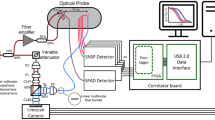Abstract
Accurate electrical transfer impedance measurement at the high frequencies (>1 MHz) required to characterise blood and intracellular structures is very difficult, owing to stray capacitances between lead wires. To solve this problem, an optically isolated measurement system has been developed using a phaselocked-loop technique for synchronisation between current injection (drive) and voltage measurement (receive) circuits. The synchronisation error between drive and receive circuits was less than 1 ns. The accuracy and reproducibility of the developed system was examined using a tissue equivalent Cole model consisting of two resistors and one capacitor. The absolute value Z and phase shift θ in impedance of the Cole model was measured at 1.25 MHz by both an LCR meter and the isolated measurement system. The difference between the values measured by the isolated measurement system and those measured by the LCR meter was less than 0.27 Ω (2.9%) in Z and 0.79 degree in θ. The standard deviation was less than 0.09Ω in Z and 0.60 degree in θ.
Similar content being viewed by others
References
Brown, B. H., Tidy, J. A., Boston, K., Blackett, A. D., Smallwood, R. H., andSharp, F. (2000): ‘Relation between tissue structure and imposed electrical current flow in cervical neoplasia’,Lancet,355, pp. 892–895
Cole, K. S., andCole, R. H. (1941): ‘Dispersion and absorption in dielectrics’,J. Chem. Phys.,9, pp. 341–351
Lu, L., Hamzaoui, L., Brown, B. H., Rigaud, B., Smallwood, R. H., Barber, D. C., andMorucci, J. P. (1996): ‘Parametric modelling for electrical impedance spectroscopy system’,Med. Biol. Eng. Comput.,34, pp. 122–126
McAdams E. T., Henry, P., andAnderson J. M. C. C. (1992): ‘Optimal electrolytic chloriding of silver ink electrodes’,Clin. Phys. Physiol. Meas.,13, pp. 19–23
Nebuya, S., Brown, B. H., Smallwood, R. H., Milnes, P., Waterworth, A. R., andNoshiro, M. (1999): ‘Measurement of high frequency electrical transfer impedances from biological tissues’,Electron. Lett.,35, pp. 1985–1987
Scharfetter, H., Hartinger, P., Hinghofer-Szalkay, H., andHutten, H. (1998): ‘A model of artefacts produced by stray capacitance during whole body or segmental bioimpedance spectroscopy’,Physiol. Meas.,19, pp. 247–261
Author information
Authors and Affiliations
Corresponding author
Rights and permissions
About this article
Cite this article
Nebuya, S., Noshiro, M., Brown, B.H. et al. Accuracy of an optically isolated tetra-polar impedance measurement system. Med. Biol. Eng. Comput. 40, 647–649 (2002). https://doi.org/10.1007/BF02345303
Received:
Accepted:
Issue Date:
DOI: https://doi.org/10.1007/BF02345303




